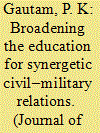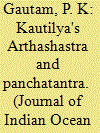|
|
|
Sort Order |
|
|
|
Items / Page
|
|
|
|
|
|
|
| Srl | Item |
| 1 |
ID:
166051


|
|
|
|
|
| Summary/Abstract |
Statecraft, diplomacy and warfare are not only a matter of brute force, but also a function of scholarship to understand the past, present and future of the art, science and literature of national and international security. At higher levels in their professional career, besides the armed forces, a number of civil servants too have to deal with the state’s use or threat of the use of legitimate force. This article suggests broadening the education for synergetic civil–military relations (CMR). This education needs to be imparted, and sustained, in the military as well as in the civil domain, including in particular the political leadership, bureaucracy, and the academic community. By doing this, a healthy CMR will generate superior strategies.
|
|
|
|
|
|
|
|
|
|
|
|
|
|
|
|
| 2 |
ID:
188874


|
|
|
|
|
| Summary/Abstract |
Traditionally, Kautilya or Vishnugupta, is considered the author of Arthashastra. He is also known as Chanakya, the scholar and chief minister who ‘destroyed the power of the Nandas and placed Chandragupta Maurya on the throne of Magadha’ in the 4th century bc. By the name of Chanakya, he had also authored a text known as Chanakya Niti. However, there is no proper understanding in the general public about the seminal work authored by Kautilya such as the Arthashastra and Chanakya Niti. Unfortunately, the term ‘Chanakya’ is used as an adjective very loosely in media or public discourse with negative Machiavellian connotations, mainly because of lack of knowledge. Kautilya’s Arthashastra is a very different and comprehensive manual and is not the same as Chanakya Niti, as is wrongly understood by many. Considering the need to set right a common misunderstanding or confusion about these texts, this commentary aims to throw light on this literature. It first introduces in brief Kautilya’s Arthashastra followed by an introduction to Chanakya Niti and the rigorous contemporary scholarship associated with it. It also features some selected verses from Chanakya Niti.
|
|
|
|
|
|
|
|
|
|
|
|
|
|
|
|
| 3 |
ID:
130604


|
|
|
|
|
| Publication |
2014.
|
| Summary/Abstract |
Kautilya"s Arthasastra composed and compiled, in Sanskrit, between the 4"' Century BCE to the 3"' Century CE, is an exhaustive treatise on statecraft and issues of diplomacy, war, peace. intelligence, security, law, and political economy. Discovered in full text form in the early 1900s and then translated into English and
other languages, it is one gem of political theory which stands out prominently in the corpus of the rich but under-explored indigenous ancient history of India. Johann Jakob Meyer, the German lndologist and translator of the work from Sanskrit to German in 1927, remarked that Kautizya's Arthasastra is not a book but a library of ancient India.
|
|
|
|
|
|
|
|
|
|
|
|
|
|
|
|
|
|
|
|
|